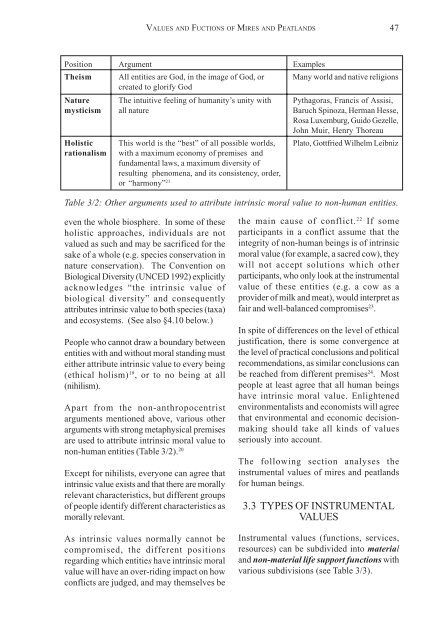wise use of mires and peatlands - Peatland Ecology Research Group
wise use of mires and peatlands - Peatland Ecology Research Group
wise use of mires and peatlands - Peatland Ecology Research Group
You also want an ePaper? Increase the reach of your titles
YUMPU automatically turns print PDFs into web optimized ePapers that Google loves.
VALUES AND FUCTIONS OF MIRES AND PEATLANDS47Position Argument ExamplesTheism All entities are God, in the image <strong>of</strong> God, or Many world <strong>and</strong> native religionscreated to glorify GodNature The intuitive feeling <strong>of</strong> humanity’s unity with Pythagoras, Francis <strong>of</strong> Assisi,mysticism all nature Baruch Spinoza, Herman Hesse,Rosa Luxemburg, Guido Gezelle,John Muir, Henry ThoreauHolistic This world is the “best” <strong>of</strong> all possible worlds, Plato, Gottfried Wilhelm Leibnizrationalism with a maximum economy <strong>of</strong> premises <strong>and</strong>fundamental laws, a maximum diversity <strong>of</strong>resulting phenomena, <strong>and</strong> its consistency, order,or “harmony” 21Table 3/2: Other arguments <strong>use</strong>d to attribute intrinsic moral value to non-human entities.even the whole biosphere. In some <strong>of</strong> theseholistic approaches, individuals are notvalued as such <strong>and</strong> may be sacrificed for thesake <strong>of</strong> a whole (e.g. species conservation innature conservation). The Convention onBiological Diversity (UNCED 1992) explicitlyacknowledges “the intrinsic value <strong>of</strong>biological diversity” <strong>and</strong> consequentlyattributes intrinsic value to both species (taxa)<strong>and</strong> ecosystems. (See also §4.10 below.)People who cannot draw a boundary betweenentities with <strong>and</strong> without moral st<strong>and</strong>ing musteither attribute intrinsic value to every being(ethical holism) 19 , or to no being at all(nihilism).Apart from the non-anthropocentristarguments mentioned above, various otherarguments with strong metaphysical premisesare <strong>use</strong>d to attribute intrinsic moral value tonon-human entities (Table 3/2). 20Except for nihilists, everyone can agree thatintrinsic value exists <strong>and</strong> that there are morallyrelevant characteristics, but different groups<strong>of</strong> people identify different characteristics asmorally relevant.As intrinsic values normally cannot becompromised, the different positionsregarding which entities have intrinsic moralvalue will have an over-riding impact on howconflicts are judged, <strong>and</strong> may themselves bethe main ca<strong>use</strong> <strong>of</strong> conflict. 22 If someparticipants in a conflict assume that theintegrity <strong>of</strong> non-human beings is <strong>of</strong> intrinsicmoral value (for example, a sacred cow), theywill not accept solutions which otherparticipants, who only look at the instrumentalvalue <strong>of</strong> these entities (e.g. a cow as aprovider <strong>of</strong> milk <strong>and</strong> meat), would interpret asfair <strong>and</strong> well-balanced compromises 23 .In spite <strong>of</strong> differences on the level <strong>of</strong> ethicaljustification, there is some convergence atthe level <strong>of</strong> practical conclusions <strong>and</strong> politicalrecommendations, as similar conclusions canbe reached from different premises 24 . Mostpeople at least agree that all human beingshave intrinsic moral value. Enlightenedenvironmentalists <strong>and</strong> economists will agreethat environmental <strong>and</strong> economic decisionmakingshould take all kinds <strong>of</strong> valuesseriously into account.The following section analyses theinstrumental values <strong>of</strong> <strong>mires</strong> <strong>and</strong> peatl<strong>and</strong>sfor human beings.3.3 TYPES OF INSTRUMENTALVALUESInstrumental values (functions, services,resources) can be subdivided into material<strong>and</strong> non-material life support functions withvarious subdivisions (see Table 3/3).
















